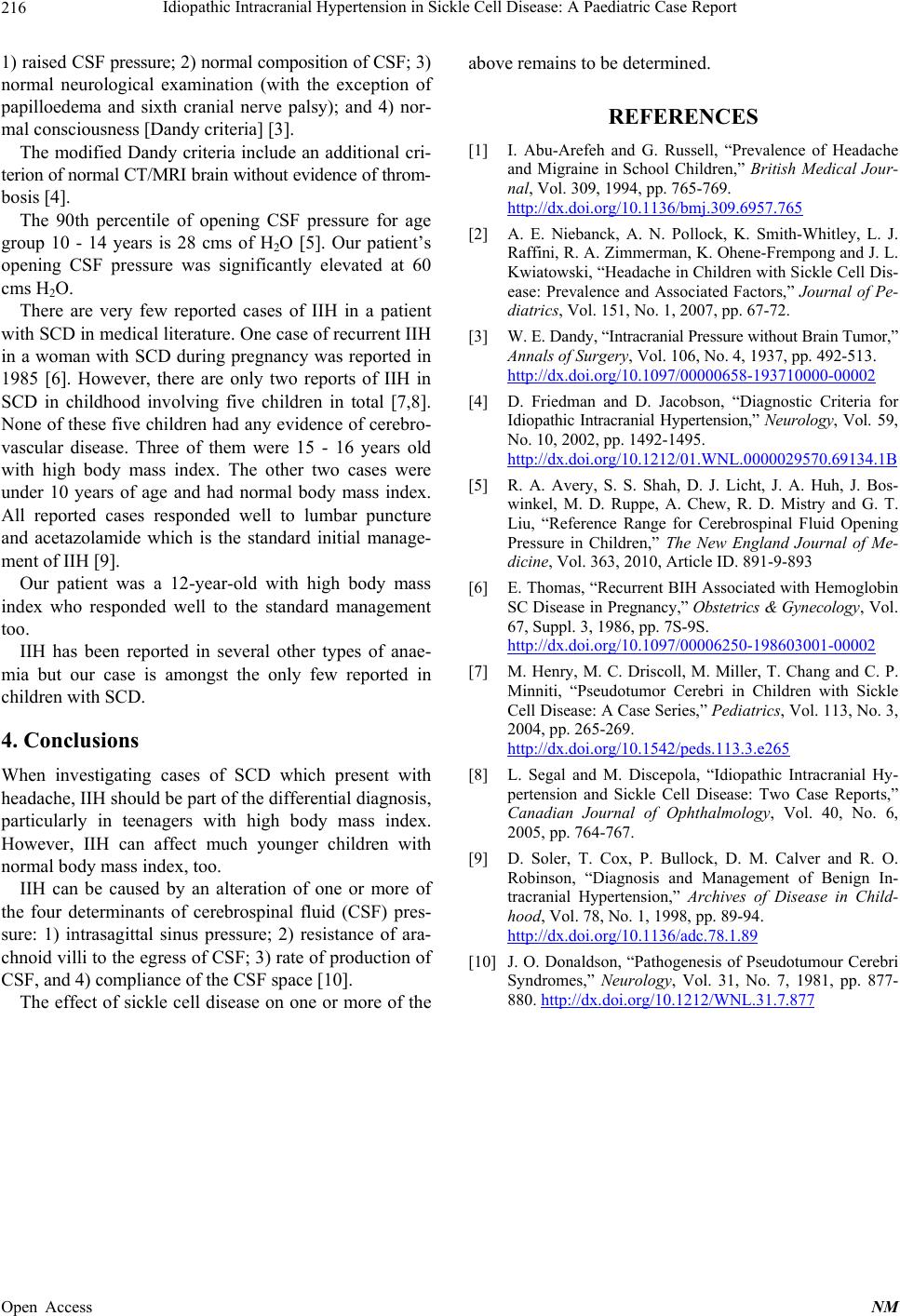
Idiopathic Intracranial Hypertension in Sickle Cell Disease: A Paediatric Case Report
216
1) ra ise d CSF pressure; 2) normal composition of CSF; 3)
normal neurological examination (with the exception of
papilloedema and sixth cranial nerve palsy); and 4) nor-
mal consciousness [Dandy criteria] [3].
The modified Dandy criteria include an additional cri-
terion of normal CT/MRI brain without evidence of throm-
bosis [4 ].
The 90th percentile of opening CSF pressure for age
group 10 - 14 years is 28 cms of H2O [5]. Our patient’s
opening CSF pressure was significantly elevated at 60
cms H2O.
There are very few reported cases of IIH in a patient
with SCD in medical literature. One case of recurrent IIH
in a woman with SCD during pregnancy was reported in
1985 [6]. However, there are only two reports of IIH in
SCD in childhood involving five children in total [7,8].
None of these five children had any evidence of cerebro-
vascular disease. Three of them were 15 - 16 years old
with high body mass index. The other two cases were
under 10 years of age and had normal body mass index.
All reported cases responded well to lumbar puncture
and acetazolamide which is the standard initial manage-
ment of IIH [9].
Our patient was a 12-year-old with high body mass
index who responded well to the standard management
too.
IIH has been reported in several other types of anae-
mia but our case is amongst the only few reported in
children with SCD.
4. Conclusions
When investigating cases of SCD which present with
headache, IIH should be part of the differential diagnosis,
particularly in teenagers with high body mass index.
However, IIH can affect much younger children with
normal body mass index, too.
IIH can be caused by an alteration of one or more of
the four determinants of cerebrospinal fluid (CSF) pres-
sure: 1) intrasagittal sinus pressure; 2) resistance of ara-
chnoid villi to the egress of CSF; 3) rate of produ ction of
CSF, and 4) compliance of the CSF space [10].
The effect of sickle cell disease on one or more of the
above remains to be determined.
REFERENCES
[1] I. Abu-Arefeh and G. Russell, “Prevalence of Headache
and Migraine in School Children,” British Medical Jour-
nal, Vol. 309, 1994, pp. 765-769.
http://dx.doi.org/10.1136/bmj.309.6957.765
[2] A. E. Niebanck, A. N. Pollock, K. Smith-Whitley, L. J.
Raffini, R. A. Zimmerman, K. Ohene -Frempong and J. L.
Kwiatowski, “Headache in Children with Sickle Cell Dis-
ease: Prevalence and Associated Factors,” Journal of Pe-
diatrics, Vol. 151, No. 1, 2007, pp. 67-72.
[3] W. E. Dandy, “I ntracranial Pressure without Brai n Tumor,”
Annals of Surgery, Vol. 106, No. 4, 1937, pp. 492-513.
http://dx.doi.org/10.1097/00000658-193710000-00002
[4] D. Friedman and D. Jacobson, “Diagnostic Criteria for
Idiopathic Intracranial Hypertension,” Neurology, Vol. 59,
No. 10, 2002, pp. 1492-1495.
http://dx.doi.org/10.1212/01.WNL.0000029570.69134.1B
[5] R. A. Avery, S. S. Shah, D. J. Licht, J. A. Huh, J. Bos-
winkel, M. D. Ruppe, A. Chew, R. D. Mistry and G. T.
Liu, “Reference Range for Cerebrospinal Fluid Opening
Pressure in Children,” The New England Journal of Me-
dicine, Vol. 363, 2010, Article ID. 891-9-893
[6] E. Thomas, “Recurrent BIH Associated with Hemoglobin
SC Disease in Pregnancy,” Obstetrics & Gynecology, Vol.
67, Suppl. 3, 1986, pp. 7S-9S.
http://dx.doi.org/10.1097/00006250-198603001-00002
[7] M. Henry, M. C. Driscoll, M. Miller, T. Chang and C. P.
Minniti, “Pseudotumor Cerebri in Children with Sickle
Cell Disease: A Case Series,” Pediatrics, Vol. 113, No. 3,
2004, pp. 265-269.
http://dx.doi.org/10.1542/peds.113.3.e265
[8] L. Segal and M. Discepola, “Idiopathic Intracranial Hy-
pertension and Sickle Cell Disease: Two Case Reports,”
Canadian Journal of Ophthalmology, Vol. 40, No. 6,
2005, pp. 764-767.
[9] D. Soler, T. Cox, P. Bullock, D. M. Calver and R. O.
Robinson, “Diagnosis and Management of Benign In-
tracranial Hypertension,” Archives of Disease in Child-
hood, Vol. 78, No. 1, 1998, pp. 89-94.
http://dx.doi.org/10.1136/adc.78.1.89
[10] J. O. Donaldson, “Pathogenesis of Pseudotumour Cerebri
Syndromes,” Neurology, Vol. 31, No. 7, 1981, pp. 877-
880. http://dx.doi.org/10.1212/WNL.31.7.877
Open Access NM